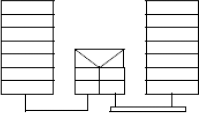Chapter 10
Routing Protocols

This chapter presents the general principles of router functioning and the different types of routing protocols.
Chapter 11 presents the internal routing protocols RIP, OSPF and IS-IS.
Chapter 12 presents the external routing protocol BGP.
10.1. Routing tables
The IP protocol and addressing space allocation by a single organism have allowed the creation of a worldwide covering network. For a packet to reach its destination, it must go through routers that transport it. A router is a device that has several interfaces1. It contains tables determining the output interface based on the packet’s destination address.
An address has several functions in the Internet:
— Localization: i.e. being able to find the location of a device in the network. This function is of interest for the routing of packets;
— Identification: i.e. designates a unique device. Identification is used by TCP to locate a connection.
A routing table, also called a FIB (forwarding information base), can be summarized by two kinds of information: to go towards the correct destination, packets must exit by such interface.
— The destination can either be an IP network or subnetwork (i.e. a set of devices sharing a common address part), or a particular device. In the case of a device, the complete IP address is given. For an IP network, bits reserved for the device number are set to 0. The ...
Get Local Networks and the Internet: From Protocols to Interconnection now with the O’Reilly learning platform.
O’Reilly members experience books, live events, courses curated by job role, and more from O’Reilly and nearly 200 top publishers.

